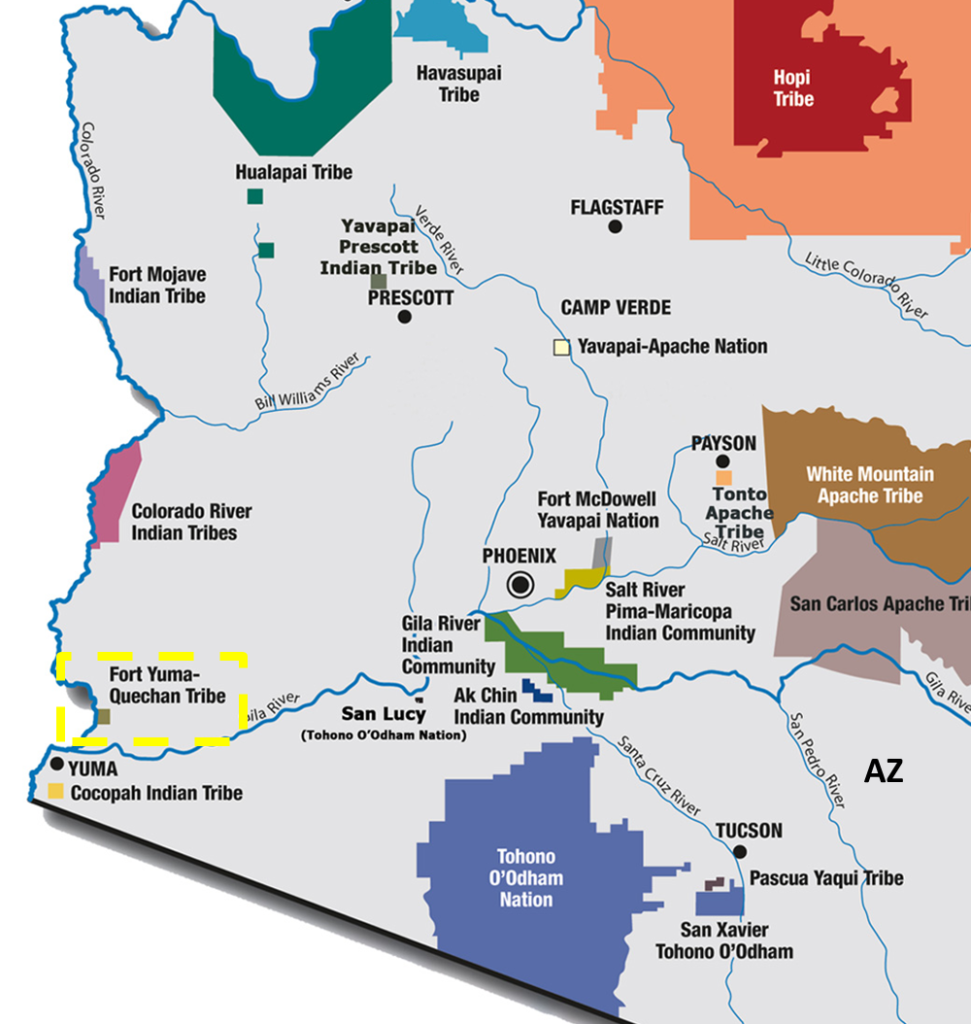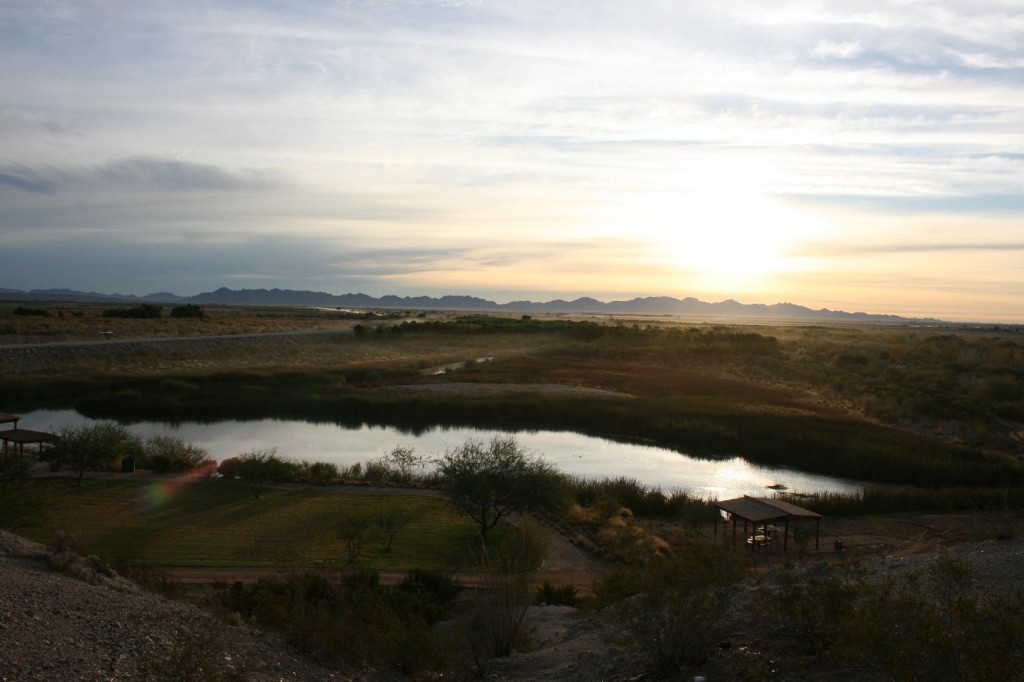Reservation
The Fort Yuma Reservation is located on both sides of the Colorado River in Southwestern Arizona and Southern California near Yuma, Arizona. The reservation is approximately 45,000 acres.[i] The reservation was established in an Executive Order signed by President Chester A. Arthur in 1884. The designation gave approximately 72 square miles to the Quechan Tribe as the Fort Yuma Indian Reservation.[ii]
Population
According to the most recent data from the Tribal Enrollment Office, the Tribe’s population totals 2,475 members.[iii]
Settlement
The Tribe possesses present perfected federally-reserved water rights from the mainstream of the Colorado River under the decree in Arizona v. California, supplemental decrees (1979 and 1984), and final Consolidated Decree (2006).
The 2006 Consolidated Final Decree, which incorporated and finalized all the previous holdings from the Arizona v. California cases, specified that the Tribe was entitled to 6,350 acre-feet annually (“afa”) (or the amount of water necessary to irrigate 952 acres, whichever was less) from Arizona and an increase of 20,000 afa (or the amount of water necessary to irrigate 2,998 acres, whichever was less) from California (for a total of 71,616 afa/10,742 acres from California).[iv] In total, the reservation is entitled to 77,966 afa of diversions from the mainstream of the Colorado River (or the amount of water necessary to irrigate 11,694 acres and related uses, whichever of is less), with a priority date of January 9, 1884.[v]
The Tribe was involved in all three Arizona v. California cases, represented by the federal government in each case. The United States asserted federally-reserved water rights on behalf of itself and five Indian tribes, including the Quechan Tribe.[vi] At issue were both the boundaries of the reservation and—in the event that the reservation was expanded—whether the Tribe’s water rights could be re-quantified in light of new tribal lands. Basically, there was a dispute about whether the Tribe had ceded certain lands that now had a giant diversion canal running across the lands (and thus whether the Tribe should be receiving payment for the use of the lands). The Tribe offered to cede rights to 25,000 acres of the reservation to the United States in exchange for allotments of irrigated land to individual farmers. The related agreement was ratified in 1893.[vii]
In 2000, the Supreme Court ruled that the Tribe’s water rights were not included in the settlement of land claims concerning part of the Fort Yuma Reservation. The Court remanded the case to quantify the Tribe’s water rights, resulting in the 2006 Final Decree. Ultimately, the Supreme Court decided that the Tribe had not permanently ceded most of the disputed lands, and that the water settlement could be tweaked to reflect this change to the reservation boundaries.[viii]
The Tribe received a total of 77,966 afa of water in Arizona v. California with a priority date of January 9, 1884. The Tribe is currently engaged in litigation in Arizona v. California to acquire additional water rights in California.[ix]
Sources of Water
The water source for the reservation is the mainstream of the Colorado River.[x]
Water Use Information
The Tribe has the sovereign right and authority to regulate the use of its water resources. Currently the Tribe has committed a portion of its water rights to uses within its reservation boundaries, including a 700-acre farm the Tribe leases to a non-Indian farmer, five trailer and RV parks, a museum, and a bingo hall.[xi]
Each member tribe of the Ten Tribes Partnership, like the Quechan, can utilize their water entitlements for the ultimate benefit of their members through voluntary tribal transfers. A voluntary tribal transfer will likely include, but is not limited to, water banking, water marketing, leasing, and forbearance agreements. These transfers can be to any existing user of Colorado River water regardless of geographic limits. This can be seen through the Quechan Tribe’s agreement to market a portion of its water to the California Metropolitan Water District (“MWD”).[xii]
In 2007, the Tribe worked with the EPA, the City of Yuma, and the Yuma Crossing Heritage Area to carry out a multi-phased project to restore 1,418 acres of the Lower Colorado River Delta region. Nearly half of the restoration area is on the Fort Yuma Reservation.[xiii]
Water Marketing
The Tribe has been marketing a portion of its Winters entitlement to the MWD. In years when the Tribe does not utilize its entire Winters entitlement, the MWD can receive the excess in exchange for a cash payment. The Tribe has the sole authority to annually choose to forebear (or not to forbear) from using a portion of its water rights to market to the MWD. The agreement was approved by the federal government and the Supreme Court in the 2006 Final Decree.[xiv]
The Ten Tribes Partnership used the Tribe’s circumstances as a poster child for satisfying diverse interests through water marketing. Explaining that the Tribe “has a Winters entitlement amounting to more than its current needs” and that the MWD “was facing drought, scarcity, and a severe need for additional water supplies,”[xv] the Partnership brought attention to the successful collaboration that eventually resulted in a marketing agreement between the Tribe and the MWD. Markedly, the MWD had at one time been adamantly opposed to tribal water-marketing.[xvi] The initial quantity of water available under the marketing agreement is 13,000 afa with an additional 7,000 acre feet available in 2035.[xvii]
Contact:
350 Picacho Road
Winterhaven, CA 92283
Phone: (760) 572-0213
If you would like to learn more about the this tribe, click here to go to their website.
[i] Quechan Tribe, Inter-Tribal Council of Arizona, Inc., http://itcaonline.com/?page_id=1173 (last visited June 10, 2013).
[ii] Heather R. Brinton, Arizona v. California: Riding the Wave of Federal Riparianism, 13 Vill. Envtl. L.J. 59, 64 n.29 (2002).
[iii] Quechan Tribe, supra note 1.
[iv] Katherine Ott Verburg, Reclamation Bureau, Colorado River Documents 2008, Government Printing Office (2011).
[v] Arizona v. California, 547 U.S. 150, 157-58, (2006).
[vi] Hoopa Valley Tribe, 2009 California Tribal Water Summit, Tribal Water Authorities—Rivers, Dams, & Fish 2 (2009).
[vii] Brinton, supra note 2, 64 n.29.
[viii] For a summary of the Quechan involvement in the Arizona v. California cases, see John J. Goodman, Arizona v. California III: Res Judicata, Collateral Estoppel, and Indian Water Rights, 19 J. Nat. Resources & Envtl. L. 273, 277 (2005).
[ix] Position Paper of the Ten Indian Tribes with Water Rights in the Colorado River Basin, submitted to the Seven States in the Colorado River Basin (1992).
[x] Ten Tribes Partnership’s Proposed Option: Voluntary Tribal Water Transfers. Letter to the Bureau of Reclamation. 2, [hereinafter Ten Tribes]
http://www.usbr.gov/lc/region/programs/crbstudy/144_Voluntary_Tribal_Water_Transfers.pdf.
[xi] Quechan Tribe, supra note 1.
[xii] Ten Tribes, 2.
[xiii] Healthy Tribal Communities, United States Environmental Protection Agency, http://www.epa.gov/region9/tribal/success/07/communities.html (last updated Sept. 10, 2012).
[xiv] Arizona, 547 U.S. at 157-58.
[xv] Ten Tribes, 2.
[xvi] Id.
[xvii] Id.

